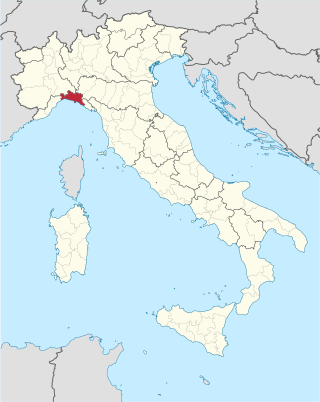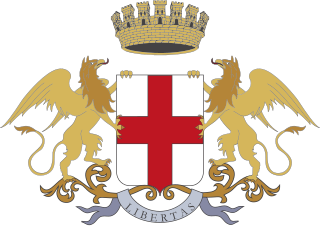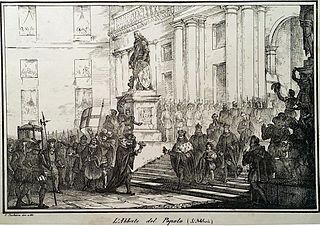
Liguria is a region of north-western Italy; its capital is Genoa. Its territory is crossed by the Alps and the Apennines mountain range and is roughly coextensive with the former territory of the Republic of Genoa. Liguria is bordered by France to the west, Piedmont to the north, and Emilia-Romagna and Tuscany to the east. It rests on the Ligurian Sea, and has a population of 1,557,533. The region is part of the Alps–Mediterranean Euroregion.

The Doge of Genoa was the head of state of the Republic of Genoa, a city-state and soon afterwards a maritime republic, from 1339 until the state's extinction in 1797. Originally elected for life, after 1528 the Doges were elected for terms of two years. The Republic was ruled by a small group of merchant families, from whom the doges were selected.

The Republic of Genoa was a medieval and early modern maritime republic from the 1099 to 1797 in Liguria on the northwestern Italian coast. During the Late Middle Ages, it was a major commercial power in both the Mediterranean Sea and the Black Sea. Between the 16th and 17th centuries, it was one of the major financial centers in Europe.

The Roman Republic was a sister republic of the First French Republic. It was proclaimed on 15 February 1798 after Louis-Alexandre Berthier, a general of the French Revolutionary Army under the rule of Napoleon Bonaparte, had occupied the city of Rome on 10 February. It was led by a Directory of five men and comprised territory conquered from the Papal States. Pope Pius VI was exiled to France and died there in August 1799. The Roman Republic immediately took control of the other two former-papal revolutionary administrations, the Tiberina Republic and the Anconine Republic. The Roman Republic proved short-lived, as Neapolitan troops restored the Papal States in October 1799.

The history of early modern Italy roughly corresponds to the period from the Renaissance to the Congress of Vienna in 1814. The following period was characterized by political and social unrest which then led to the unification of Italy, which culminated in 1861 with the proclamation of the Kingdom of Italy.

Apennins was a department of the First French Empire of 1805-1814 in present-day Italy. Named after the Apennine Mountains, it originated on 6 June 1805, after France had directly annexed the Ligurian Republic on 4 June 1805. Its capital was Chiavari.

Marengo was a department of the French Consulate and of the First French Empire in present-day Italy. It was named after the Marengo plain near Alessandria to commemorate the eponymous French victory. It was formed in 1802, detaching part of the department of Tanaro, when the Subalpine Republic was directly annexed to France. Its capital was Alessandria, formerly the capital of Tanaro.

The Province of Genoa was a province in the Liguria region of Italy. Its capital was the city of Genoa. It was replaced by Metropolitan City of Genoa.

A sister republic was a republic established by French armies or by local revolutionaries and assisted by the First French Republic during the French Revolutionary Wars. These republics, though nominally independent, relied heavily on France for protection, making them more akin to autonomous territories rather than independent states. This became particularly evident after the declaration of the French Empire, when several states were annexed, and the remaining turned into monarchies ruled by members of the Bonaparte family.

The Subalpine Republic was a short-lived republic that existed between 1800 and 1802 on the territory of Piedmont during its military rule by the French Consulate.

Novi Ligure is a city and comune north of Genoa, in the Piedmont region of the province of Alessandria of northwest Italy.

Genoa, Italy, has historically been one of the most important ports on the Mediterranean.
The Ligurian Independentist Movement was a regional political party in Italy.

The Delle Piane family is an old Genoese noble family first recorded in Polcevera in 1121. Over the past ten centuries it has produced many distinguished government officials, clerics, diplomats, soldiers and patrons.

Giacomo Maria Brignole Sale was the 176th and 184th Doge of the Republic of Genoa, respectively from 1779 to 1781 and from 1795 to 1797. He was the last doge in the history of the Republic, and the only one elected twice, a unique case in the history of that Republic for the biennial election doges. After Brignole's dogeship the Genoese state and the office were abolished.

The Piedmontese Republic was a revolutionary, provisional and internationally unrecognized government established in Turin between 1798 and 1799 on the territory of Piedmont during its military rule by the French First Republic.

Michelangelo Cambiaso member of a Genoese patrician family, was a Genoese politician, as well as Doge of the Republic of Genoa and French senator under the First French Empire.

The Great Council and Minor Council were the two chambers of the political system of the Republic of Genoa that elected the Doge from 1528 to 1797.

The Confeugo is an ancient cultural event in Liguria, traditionally celebrated on Christmas Eve or a couple of days before Christmas. It is a historical event linked to the Republic of Genoa and is still commemorated today mainly in Genoa and Savona, but also in other Ligurian Municipalities that were once the seat of podesterie and capitaneati.
The Republic of Genoa recognized the United States in 1791, but both countries never established formal diplomatic relations. Relations continued until 1805 when the Republic was annexed by France under Napoleon.




















